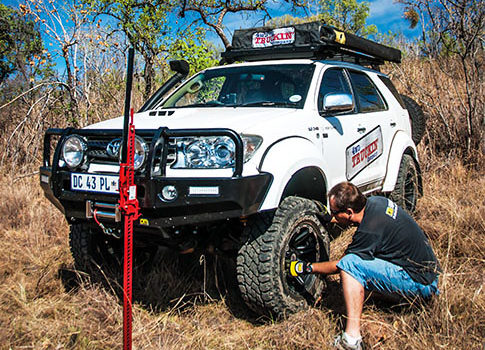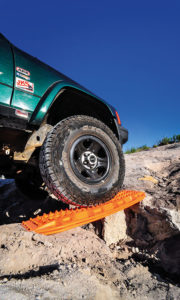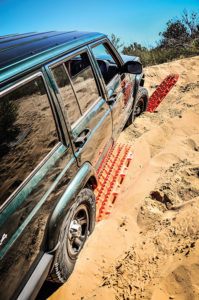When the tar ends and serious off-road begins, there are vital items you should always carry with you. Grant Spolander gives the low-down on the essential recovery gear
Fifteen years ago, the South African 4×4 industry was in its infancy. Back then, 4×4s were viewed as tools, not toys.
A short while later, an increasing number of vehicle manufacturers began adding off-road models to their product lines.
At the same time, a few entrepreneurs here in SA caught on to the fact that the recreational 4×4 market was booming in Australia, where there was huge product development going on in the accessories department. A lot of these products made their way to our shores and, with rapid effect, the recreational off-road industry was born and flourishing here in South Africa, too.
As the industry grew, more products came on to the scene and innovation became the order of the day. In no time at all, the 4×4 market became burdened by its own superfluous bulk, creating the unfortunate misperception that off-road travel was expensive and only possible with truckloads of kit.
During my seven years as an off-road travel writer, I’d often fly into Joburg, collect a stock-standard 4×4 at the airport and then disappear into neighbouring Southern Africa − equipped with little more than a one-man tent and a trolley-load of canned tuna. Admittedly, these trips weren’t as comfortable as they could have been, but (despite having to deal with endless punctures) I was frequently amazed at just how little was required to enjoy an overland adventure.
The most daunting notion for many off-road travellers is that of becoming stuck. It’s a reasonable concern; as you push the boundaries of adventure, the likelihood of finding yourself bogged down one day increases dramatically. Fortunately, there are tools that can reduce the chance of this happening − none of them overly expensive, either. So, without further ado, these are the five essential tools every 4×4 owner should invest in.
Tyres
You could argue that buying tyres when your 4×4 already has a set is a waste of money … but nothing could be further from the truth. Tyres are your vehicle’s most valued component. Sadly, almost every original-equipment fitted tyre (even those on reputable 4×4s) is inadequate in the traction and durability department.
Having to endure endless punctures, blown sidewalls and a lack of traction is a sure-fire way to ruin your off-road holiday. Bear in mind that tyre-sidewall damage often occurs when you’re trekking over mountainous terrain or sharp rocks – not exactly the ideal place to jack up a vehicle and stick on a spare.
Spade
Sure, an expensive 12 000 lb winch will haul you out of most situations; but, in terms of bang for your buck, no recovery tool is as straight-talking as a spade. (Well, strictly speaking, what you really want is a shovel – something with a deep blade that can hold lots of sand.)
Almost any recovery situation requires three things: a plan, patience, and good, old-fashioned hard work. The moment you attempt to skip one of these elements (particularly that of thinking up a plan), you’re in for a long and arduous process that’s likely to get a lot worse before it gets better.
Beads of sweat, blistered palms and a R300 shovel will see you through most off-road problems, but don’t cut corners. Be 100% sure that you have removed (i.e. dug out) all obstructions from your vehicle’s undercarriage. The rule is you must be able to see daylight under the full length of your 4×4’s chassis before driving off. So, dig until you can’t dig any more, take a break, and dig some more. If you rush the process and drive too soon, there’s a good chance you will end up more stuck than you were before.
Compressor and puncture-repair kit
Every 4×4 owner who wants to explore the back roads of nowhere must at all times carry a 12V air compressor and a puncture-repair kit. But, before you head off to the hardware store to buy what looks like a fish-pond pump, stop.
What you’re looking for is a bona fide heavy-duty air compressor capable of delivering adequate air pressure and volume. If the unit looks like it’s made entirely of plastic, chances are it’s a light-duty, Christmas-cracker compressor that won’t be up to the task. Remember, the air compressors that come standard in luxury sedans are designed to top up the air in one or two low-profile tyres, not to re-inflate four massive off-road tyres from 1.0 to 2.2 bar.
Recovery tracks
A good set of recovery tracks should be ridged, firm and able to support your vehicle’s mass. I’ve found that flexible, fold-up, roll-up or fill-up recovery tracks are seldom worth the trouble – they have the unfortunate tendency to sink under the considerable weight of a 4×4. What you need is something that spreads out your vehicle’s mass and functions as a platform for it to climb up and on to. The moment your 4×4 is able to lift itself out of a boggy situation, half the recovery work is done.
However, the important thing to remember with recovery tracks is that prevention is better than cure. In other words, don’t wait to use them once the problem is there. Instead, be proactive; if you see a potentially sticky situation, lay down the tracks before you get stuck. With this in mind, it is important that you keep your recovery tracks somewhere easily accessible. Don’t pack them under your camping gear; keep them close at hand and easy to use.
In terms of personal preference, I’m a big fan of Australian product Maxtrax. These tracks aren’t cheap, but they are worth the money and noticeably better than the competition.
High-lift jack
The high-lift jack has been around since the early 1900s. Besides being a tried-and-trusted tool with bulletproof construction, it’s also incredibly versatile. A high-lift jack can be used not just to change a tyre, but to lift a vehicle out of a ditch, shift a vehicle sideways (just tilt the jack over) or even mechanically winch it forwards or backwards. And that’s just the start of its usefulness – a good friend of mine once used one of these beauties as an emergency leaf spring when his Land Cruiser snapped its rear suspension.
Unfortunately, high-lift jacks are frequently regarded as dangerous tools to operate. While this may be true at some level, the truth is – when things do go wrong – it is usually because the operator has rushed the recovery process and failed to consider all the necessary safety measures.
So, once again, remember: Take your time, think things through and roll up your sleeves.
Photography Grant Spolander
(This article was first published in the winter 2015 issue of AA traveller magazine)






